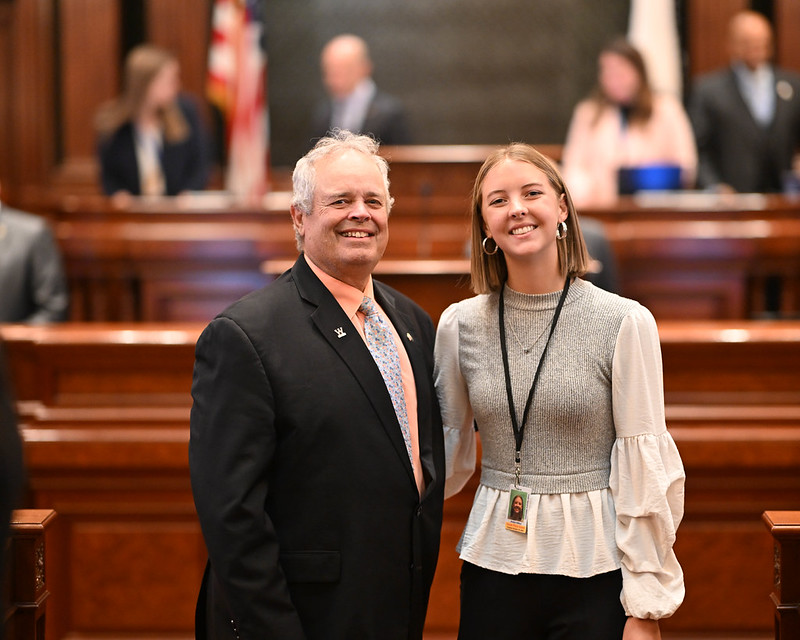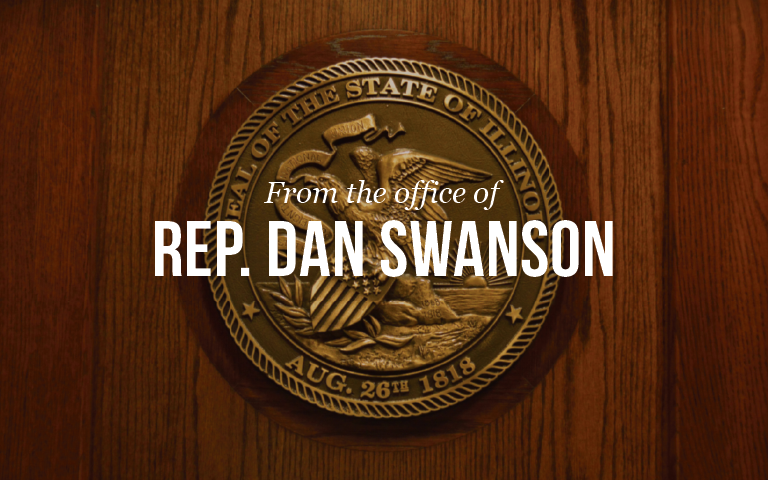Inside:
- Final week of veto session tackles transit, energy
- Senior property tax freeze legislation passes
- Illinois Veterans Home dedication
- Evelyn Wilbur serves as House Page for a Day
Final week of veto session tackles transit, energy
It was a busy few days at the Capitol during the closing week of the fall veto session. Here is a quick recap of a couple of the biggest issues.
We have been hearing about a looming “fiscal cliff” for the different mass transit systems in the Chicago area. Recently, the fiscal cliff was reduced from $770 million to $220 million, but even with the reduction Senate Bill 2111 Amendment #3 provides over $1 billion in new funds.
This year representatives of these transit systems came to Springfield asking for a bailout, and the House responded by sweeping hundreds of millions of dollars collected from the state’s gas sales tax and interest on the “lock box” road fund (motor fuel tax) to generate funds for this bailout. Funds of almost $1.1 billion were identified: an $860 million sales tax sweep and another $175 million from interest on the road fund motor fuel tax.
These funds were traditionally split with 55% going to downstate communities and 45% for northeast Illinois. The language in the legislation changes the distribution to 85% for northeast Illinois and only 15% for all of downstate. The funds will now go to the Northern Illinois Transit Authority (NITA) and will not sunset or end. As a result of the redistribution of the sales tax on motor fuel, it is a $569 million loss to downstate roads, maintenance and transit. An additional $175 million will be moved to the NITA from the interest on the road fund.
The Illinois Tollway will increase fees by $.45 per vehicle at the toll booth and a 30% increase for commercial vehicles, generating over $1 billion. The bill also included reforms to the transit system’s organizational structure and leadership. I voted No on the over $2 billion tax increase, but it passed the House and the Senate in the early morning hours on Halloween. It now goes to the Governor for his signature.
This week the General Assembly also passed a bill reminiscent of the “Green New Deal” proposed in Washington, adding costly mandates on Illinois families and businesses, providing green energy giveaways to special interests, and giving control of Illinois’ energy policy to an unelected bureaucracy. When asked, the sponsor of the bill could not show us where any immediate cost savings for Illinois ratepayers would be. Admittedly, it may be at least 5 years before reductions are realized.
The bill relies heavily on battery storage, which will be paid for by ratepayers. Another big concern is that the placement of these battery storage sites will be dictated by the state – local communities will have no say in siting decisions. Individual municipalities which have their own electricity producing capability are going to have to install batteries and by 2030, 40% of their energy must be from renewable sources. All of this will have a tremendous cost, which will fall on the backs of consumers.
This legislation will drive up costs for Illinoisans, so I voted No.
Senior property tax freeze legislation passes
Illinois residents pay the highest, or second-highest property taxes in the country. High property taxes add to the burden on Illinois families and small businesses, push employers out of the state, or prevent them from locating here in the first place. They drive away opportunities and contribute to our population loss. Reform is long overdue.
I supported a bill to increase the income threshold for the senior citizen property tax freeze to help more seniors qualify for the exemption. This legislation incorporated some Republican-sponsored ideas, namely increasing the General Homestead Exemption amount and increasing the low-income senior freeze. This will help our seniors save some money on property tax bills. Over the years I have sponsored several bills to raise the senior exemption level for property taxes.
Under the legislation passed this week, the freeze Homestead Exemption shall be:
$75,000 for taxable year 2026
$77,000 for taxable year 2027
$79,000 for taxable year 2028 and thereafter.
The bill is now on its way to the Governor.
Illinois Veterans Home dedication
Last week I attended the formal dedication of the Illinois Veterans Home in Quincy.
This completes the $300 million construction of a 260,000-square-foot residential long-term care facility and 80,000-square-foot independent living facility for Illinois veterans.
The long-term care facility houses 210 skilled-care beds with full resident amenities. The independent living building, a domiciliary, has 80 independent living units, with accommodations large enough for resident spouses and children. Currently, the Quincy Veterans’ Home supports 379 individuals in long-term skilled care and 88 residents in independent living and domiciliary care. Amenities include dining rooms with elevated meal service, living rooms with fireplaces, outdoor spaces with interactive art, a chapel, a movie theater, and a pub.
Here are a few facts about the history of the facility from History of Illinois Soldiers’ & Sailors’ Home by Charles H. Curry, who came to the Illinois Veterans’ Home in 1971, and loved it. Mr. Curry’s words may well sum up, better than anything, an overview of the Home and its residents through the years.
The idea for the Home really took after the 1885 Illinois State Encampment of the Grand Army of the Republic, when the department commander, in his address to the assembled Civil War veterans, told of his dream that each GAR Post and each of the 20,000 members “use all honorable means” to establish and maintain a soldiers’ and sailors’ home in the State of Illinois. The number of disabled veterans had increased to the degree that the consensus throughout the state was that they should be treated as honored wards of the State of Illinois. A bill was introduced and passed in the General Assembly to establish a soldiers’ and sailors’ home for disabled Illinois veterans at a cost of $200,000. Fifty-two cities offered sites for the home of the new veterans’ facility, but citizens of Quincy were determined to have the new facility, donating $17,000 of the $22,000 asking price for a piece of land on the north side of Quincy.
The formal dedication that occurred on October 19, 20 and 21, 1886, called the Soldier’s Reunion and Encampment, was said to have been one of the most flamboyant celebrations Quincy had ever known. Six hundred tents were erected by the State for the use of the veterans and named “Camp Oglesby.” Five hundred vets were housed on cots in the auditorium of St. Boniface School, and everyone in town was awakened each morning at sunrise by firing of the veteran twelve-pounder brass cannon.
You can read all 16 pages here.

Evelyn Wilbur serves as House Page for a Day
I was honored to have Evelyn Wilbur visit the House chamber during the first week of veto session as a House page for a day. Evelyn is a 10th grader at Orion High School.
Evelyn is the daughter of David and Sharon Wilbur. She is a member of Faith Family Church in Orion, and participates in in varsity golf, band, jazz band, choir, syncopation, student council, culinary club scholastic bowl and the Fellowship of Christian Athletes. She is also active in the community through such organizations as the Gray Matters Collective, American Legion Auxiliary, the Orion Community Band and her church.
This is Evelyn’s second time visiting Springfield as a House page. See her full introduction on the House floor here.
More news
Self-deporting migrant to face trial in Illinois woman’s death
After 70 harvests, Knox County farmer to retire
